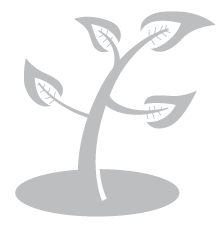
Chapter 2: When and Why Do You Prune?
In nature, pruning occurs naturally, depending on the weather and wind conditions. Some trees, such as the silver maple and boxelder, naturally drop their branches no matter what the size, and others, such as persimmon trees, naturally shed twiggy branches after bearing fruit. Animals, such as deer and rabbits, prune trees and bushes. Deer enjoy eating the branches off trees, and rabbits will feast on suckers around the root bases of trees. In addition, lower tree and shrub branches often fall off because of lack of light. But nature’s method of pruning is not always beneficial; wounds left from branches broken off in storms can lead to infection and disease, and sometimes new plants steal important nutrients from the soil of older trees, killing the older trees in the process.
Many people feel as if pruning interferes with nature, but with trees and shrubs grown in our gardens and yards, pruning often becomes important and necessary. Many reasons to prune exist: to make a plant more attractive; to create an artistic display; to improve the plant’s health by making sure the lower limbs receive adequate light and dead branches do not encourage insect infestation and disease; to ensure safety for you, your family, and your neighbors; and to encourage new growth. Man-made pruning makes trees and shrubs more attractive and helps control their growth. You may not associate pruning with safety reasons, but these situations occur often, such as when a branch blocks your vision when backing out of your driveway or when a tree grows into power lines. When pruning for the right reasons and when performed correctly with the proper tools, pruning strengthens your trees and bushes.
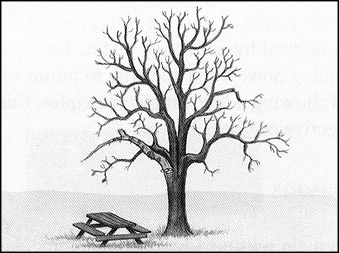
Prune for safety. Image courtesy of the USDA.
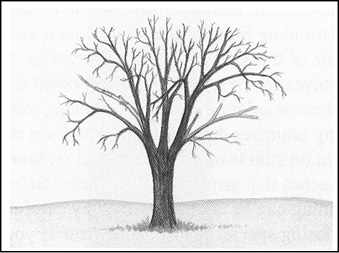
Prune for health. Image courtesy of the USDA.
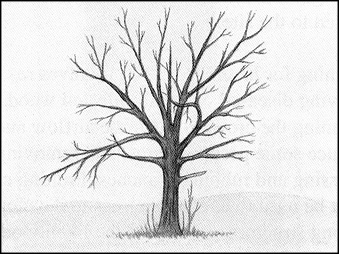
Prune for aesthetics. Image courtesy of the USDA.
You should always prune with purpose and not prune blindly. This means educating yourself about the correct tools to use for the plant you are pruning and to do so at the correct time of year or stage of the plant’s growth. This book explores these issues because each species and variety requires a different pruning approach.
A note about auxin
Auxin represents a group of chemical compounds concentrated and produced in the tip end of the stems of a plant. These chemical compounds cause the cells in the tip end to elongate and multiply, producing what we normally define as plant growth. If you cut the tip end, you remove the main auxin-producing area. This signals the next bud in line to pick up the slack in auxin production. When you cut back the stem at an angle just above a leaf node or bud, you increase the chance that the auxin production will move to the bud located on the high end of the angle. When this happens, the end bud soon becomes the dominant and more vigorous bud.
Because auxin helps cells stretch or elongate, it plays an important role in helping plants move toward the light. When a part of a plant is shaded, the auxin moves to the shaded area of the plant, causing the shaded cells to become longer. As the cells in the shaded part of the plant “stretch,” the plant is able to move toward the light.
You cannot overlook auxin’s importance in all aspects of pruning. Effective pruning involves knowing how to manipulate auxin levels to create a desired outcome. For example, when you cut the end of one stem, you must accurately predict the location of the next auxin-producing area; in other words, you must study the stem and decide which bud you want to become the dominant bud and proceed to cut back the stem just above the bud. Once you know this, you can visualize where the new growth will come from and how the plant will look after new growth appears.
Fruit and Flower Production
People prune trees to encourage fruit production on fruit trees and flower production on perennials. Some fruit trees, such as peach trees, produce fruit on 1-year-old wood and require pruning often to encourage productive new growth in a structured way. Peach trees have a short life and are prone to borers — bugs that feed on the wood of trees — and other insect problems that attack unhealthy, old, or weak growth. Pruning removes these potential problems and forces the plant to concentrate its growing energy into fewer, healthier limbs. Therefore, the plant remains healthy and remains productive longer.
Pruning can also prevent trees from blooming until they have become strong enough to bear fruit. Some fruit trees, like the pear tree, take years to bear fruit. Certain fruit trees will not bloom until they are 2 to 12 years old, depending on the kind of fruit tree. If a fruit tree produces fruit when it is too small, it may weaken the tree and prevent it from bearing fruit again for years. Therefore, you should cut off the first blooms or small fruits in order to prevent this from happening.
To continue with the example, look at some of the other problems that occur when a peach tree is never pruned and left to its own devices. A peach tree grows naturally straight up instead of into a broad, open shape, and any fruit produced is soon out of reach. As the peach tree grows out of control, numerous limbs begin crossing each other and shading out new growth. The dense growth in the tree’s canopy prevents good air circulation and encourages fungus and mildew. Peach trees tend to produce fruit in clusters, and as it produces more peaches on the excessive new growth, the fruit becomes smaller and the crops become sporadic. During some years, the tree will have a heavy fruit load and other times light. In the years where the fruit load is heavy, the excess weight can break limbs, increasing the chance that insects and disease enter the tree through the damaged areas. Proper pruning keeps the fruit in easy reach and focuses the tree’s energy to fewer peaches that grow much larger and sweeter. You can predict the crop more easily from year to year, and the tree remains healthy since you can easily notice disease and insect problems because excessive growth no longer hides them from view. As you can see, pruning a peach tree correctly creates a much better outcome.
Perennials, which are plants that can survive winter outdoors and bloom in the spring, such as hydrangeas, and which bloom on new wood — the wood produced during the current season — are often managed with the same philosophy as the peach tree. If the plant is managed in a way that produces fewer new limbs, then the plant produces larger blooms. Commercial cut flower growers, such as florists, retailers, brokers, and farmers, frequently manage blooming perennials so they produce flowers larger than average. If the plant is cut back in a way that allows the plant to grow many new branches, more blooms are produced, although they may be smaller. If you want to create larger blooms, such as those found in florist shops, you will need to remove new shoots. This way, you divert the plant’s energy into fewer growing points, resulting in larger blooms. A plant that has not had its shoots pruned will be bushier with smaller flowers. Once the flowers are spent, you will then need to remove them, a process called deadheading, so you direct the plant’s energy into making more blooms rather than seeds. This will keep your perennial energetic, and you may even get a second crop of flowers as a result.
Plants Affect Other Plant Growth
A managed landscape often has plants of all sizes that include trees, shrubs, bedding plants, and a lawn. Just as you cannot allow the lawn to grow out of control and crowd out the bedding plants, you cannot allow the woody plants to overwhelm or shade out other plants. You can clean a fast-growing tree, such as an ash, that produces many fast-growing, small branches within the canopy by properly removing the small branches. This allows more sunlight to shine through the canopy and reach the grassy areas, thus creating a healthier lawn because heavily shaded turf grass grows poorly and is susceptible to a variety of fungal and mildew diseases. You will have a healthier lawn, and plants that add color to the landscape can also thrive in the new sunny area.
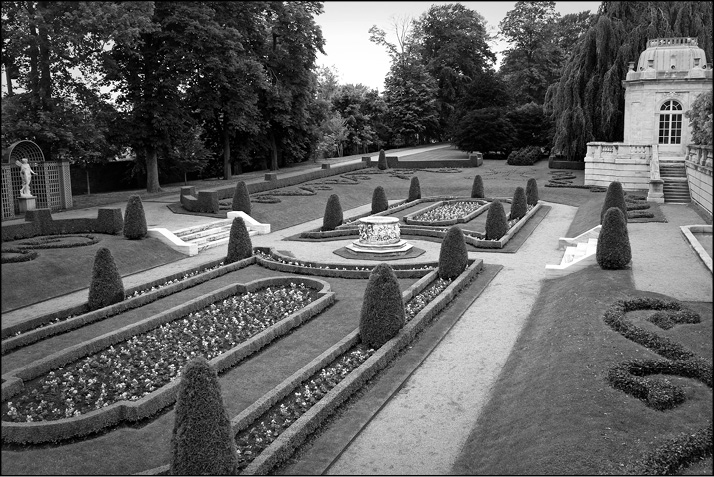
This ornate garden has highly groomed hedges, a manicured lawn, and beautiful flowers.
Many plants are considered good candidates for hedges, and pruning aids in this effort, too. For example, Leyland cypresses — which can grow up to 3 feet a year — can quickly become large trees if not pruned on a regular basis. They can also shade out other plant growth, or the excessive shade may interfere with the neighbor’s garden if allowed to grow too large. When this happens, you cannot prune the plants in a way that immediately creates a thick, attractive hedge. Or say you use a shrub as a hedge, but it has dramatically overgrown its bounds; if so, you must cut it back a little at a time, a process that may take several years. In either case, if the plants are suddenly pruned too severely, they may go into shock and die, creating more of an eyesore that is also expensive to remove.
Removing dead or diseased wood
Whether you are pruning a tree, shrub, woody perennial, rose bush, or fruit and nut tree, you need to remove dead or diseased wood during the process. One line of thought is that natural pruning occurs in nature when wind or ice breaks off dead and diseased limbs so one should wait for nature to takes its course. But, in a managed landscape, you cannot wait for this to happen. Broken limbs littering the landscape are unsightly and a fatal disease can spread throughout a plant or an entire crop of fruit trees after getting its start from one plant or tree with a damaged area. In addition, the dead or dying branches cause poor air circulation throughout the plant and can create moist conditions that promote the growth of disease-carrying organisms. Pruning these dead or dying limbs lets in more light that discourages the growth of these organisms. Therefore, it is imperative that you consistently look for dead or diseased wood on your plants and remove the wood immediately. The signs of disease will vary depending on the plant, but some common signs include discolored or falling leaves, sticky substances leaking from the tree, signs of hollowing of the trunk, limbs of a grey-brown color, and new growths around the roots. Once removed, throw all dead branches in a trash bag, and wash your pruning tools to prevent the spread of organisms, insects, and disease to other trees and shrubs in your yard.
Blocking pedestrian or vehicular traffic
If you have a house accessible by a walkway or driveway, or if it has sidewalks around it, you must control the plants that obstruct pedestrian and vehicular traffic. For example, if you live on a corner and your plants block the view of oncoming traffic or a stop sign, you could be held liable for a traffic accident that occurs because of the blocked line of sight. If the city decides to send someone to cut the tree or shrubs to create better visibility of the intersection or traffic sign, the chance of getting a professional pruning job is not good. The city will cut the offending plants more than what is needed, and you may also get the bill for the work done.
Having a hazard
Occasionally, a plant located around a house or another structure grows too large and creates places for wild animals — or even people — to hide. This creates a security issue, and it also decreases the air circulation around the structure, leading to mildew and mold problems on painted wood, brick, and stone. You must reduce the size of plants that grow too large and too close to your house or garage. You should prune them to an attractive shape, bringing them into balance with the rest of the landscape.
A limb from a large tree can weigh up to 1 ton or more, and you must remove limbs reaching out over the roof of a structure for safety’s sake. If the limb is dead or diseased, you have even more of a reason to remove it before it falls. Good candidates for removal include large limbs that can fall over a long driveway and block vehicle access, as well as any dead or diseased limbs located over an area where children play. For your own safety, you should hire a professional arborist to prune large limbs and limbs high up on the tree. Trying to handle weighty tree limbs on your own or losing your balance on a tall ladder could result in injury or even death. Costs for professional arborists and tree pruners can vary, depending on the work involved and where you live.
Training the Plant into a Specific Shape
You can prune a shrub or tree to create a specific shape that pleases the eye or goes along with your landscape theme. The theme is chosen according to personal preference and can be functional, creative, or both. For example, you can tightly prune a row of bushes into a hedge that is flat across the top and sides. You can prune the same type of shrub into a hedge with a rounded shape if you live in an area that receives heavy snowfall. This prohibits the heavy snow from piling up and breaking the small limbs of the shrub, creating gaps in the hedge that you will see when the snow melts in the spring. You can prune a small tree or large shrub to have a bare trunk and a flat top so it looks like a giant mushroom, or you can prune boxwood into the shape of an animal. If you have the right plant and the right tools, you can prune plants into incredible shapes limited only by your imagination.
Case Study: A Professional Decides When to Prune
Steve Pirus is a WSU Master Gardener and Certified Arborist in Vancouver, Washington, and a member of the International Society of Arboriculture.
We prune both to create a beautiful plant or tree and to maintain a healthy plant or tree. An arborist is actually a tree preservationist who puts the emphasis on plant health, and the artistic outcome just happens to come along with it. Typically, people choose to prune when they see a problem, meaning they visually do not like what the tree is doing or “looks” like. A knowledgeable gardener understands plant health and the reasons to prune and plans ahead, minimizing problems. It is proactive versus reactive.
First, we prune to remove any dead, dying, or diseased material — the three Ds. Next, remove any crossed branches; branches growing to the right of center should go out to the right, and branches to the left of center should go left. Otherwise the branches are competing with each other, wasting time and energy. Then, we remove suckers and water sprouts growing upright, usually straight, vertical branches.
The most common reasons for pruning would be the foliage is too low so we lift the skirt or crown. The standard height for doing this for public parks and sidewalks is 8 feet high, above the eyeballs of pedestrians, fast-running sports participants, and easy-target lawsuits. The homeowner would be well advised to plan this before power mowing and knocking his or her head.
Also view the clearing to see if foliage blocks a stop sign, the corner of an intersection, or the view of a river or ocean. Also remove any branches growing near the house exterior and banging in the wind, threatening damage to your property. Removing the limb is a much more cost-effective alternative to damaging your house.
You can also thin a tree’s crown to help prevent power failure during high winds, removing about 25 to 30 percent of the foliage at any one time but not more. If you remove too much foliage, the tree often responds to the cuts by sending up fast, new, weak sprouts rather than slower, normal, more woody growth. So know this and do not get too carried away.
You should note that an arborist never, ever tops a tree. Topping, or hard-heading back, is reducing the size of the crown or greatly reducing the diameter of the tree. It encourages decay or dying back of the cuts, which can eventually die back into the trunk, slowly killing the tree.
We also do not cut a branch without a reason. Know what and why ahead of time. With plant health being foremost on the list, always use clean, sharp tools. Why clean? You would not go to a doctor who did not use clean, sterilized tools, and yet people will let sap and gum build up on their tools for weeks, months, and years. We first clean off the old sap with water, a cleanser, and a scouring pad. Once the metal is clean, we sterilize with 90 percent alcohol or a 10-percent bleach solution. Then, carefully sharpen the tools for a safe and effective cut.
The following cuts are always mandatory and reflect the work of a pro.
All trees and woody shrubs have, if we look closely, usually two anatomical features: first, a branch collar or bulge at the base of a branch just as it grows out of a trunk or larger branch; and second, a branch, bark ridge, or furrow of bark pressed out of and between the trunk or main branch, and the smaller branch growing out from it. To promote proper healing, we always cut just outside — 1/8 inch on a 1-inch diameter branch and 1/4 inch on a larger branch — the branch bark ridge at an angle that mirrors the angle the branch bark ridge exhibits. We never ever cut off or within or violate the branch bark ridge because the cut cannot heal properly, which then encourages decay and leads to the decline and eventual death of the plant. The emphasis is placed on the proper branch bark ridge cut, but if we cannot see it — because of not looking closely enough for it — we always make an angled cut outside the branch collar. A cut that violates the branch bark ridge is called a flush cut and in basic terms reflects the work of an unskilled laborer.
On a branch with any weight on it — meaning about 3 feet long or longer and 3 to 4 inches in diameter or larger — we use a one, two, three cut. Cut number one would be out about a foot from the point of connection, cut from underneath, and at least a quarter of the way into the limb to up to about a third into it. A deeper cut may cause the weight of the limb to pinch and hold the blade, often making it impossible to remove it. Cut number two will be directly above cut number one to remove the limb. These two cuts are made to remove the limb a foot out and without tearing the bark, which is a severe injury to the tree. The third cut would be the final cut, about ¼ inch and angled, just outside the branch bark ridge. If you want to know the most important skills to prune properly, they are: clean, sharp tools, and the branch bark ridge. The rest is all window dressing.
The next important fundamental rule under health would be pruning for a healthy structure. Keep in mind that there are thousands of species of ornamental, not to mention fruiting, trees. There are varied shapes upright, like the Lombardy poplar; cone, like the pines; and round-headed, like most maples. The correct approach is to accentuate or complement the natural character of each plant. We should not attempt to force them into some sort of contrived form we imagine but accentuate their beauty instead.
With that in mind, we need to think of strength. We want to balance the foliage and, therefore, the weight distribution of the tree, helping to prevent future failures or broken branches. From a side view, we want to view the tree branches as balanced also. We want to plant in the young tree, and selectively remove branches in the established tree to balance the weight of the tree.
We do not want to look at the tree aesthetically or artistically, at least not at this point. We want to think of the branches as a skeleton developing. We want to encourage this symmetry, not in a controlled or contrived way but in a way to preserve the tree and complement its natural character.